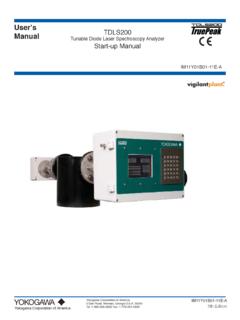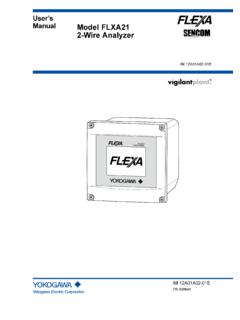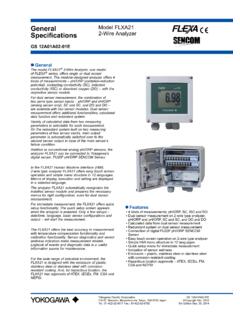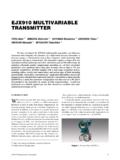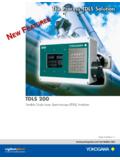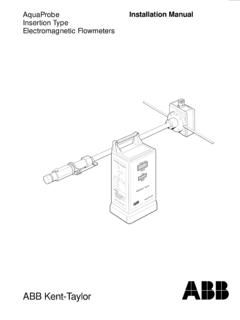Transcription of MANUAL Model YF100 (Style E) Vortex Flowmeter …
1 INSTRUCTION. MANUAL (Style E). Model YF100 . Vortex Flowmeter ( integral type , remote Type). Model YFA11. Vortex Flow Converter ( remote Type). IM 1F2B4-01-YIA. IM 1F2B4-01-YIA. 1st Edition, March 1998. Printed in TABLE OF CONTENTS. I. INTRODUCTION .. 1. General Overview .. 1. Principle of Operation .. 1. Vortex shedding .. 1. K-factor .. 2. Qmin .. 3. Uniquely Vortex .. 3. Vortex frequency .. 3. Available outputs .. 3. Standard Specifications .. 4. Basic Sizing .. 7. Flowmeter sizing .. 7. Model and Suffix Codes .. 9. II. QUICK START .. 22. Parameter Setting in BRAIN Communications .. 22. YEWFLO Setup .. 25. Liquid, gas or steam in mass flow units.
2 26. Steam flow in energy units .. 28. Gas volumetric referenced to standard conditions .. 30. Liquid, gas, or steam in volumetric units at flowing conditions .. 32. Parameter Setting in HART Communications .. 34. Communication Specifications .. 34. Hardware Recommendations .. 35. III. INSTALLATION .. 36. Piping Requirements .. 36. Pipe schedule .. 37. Flow direction and orientation .. 37. Pressure and temperature taps .. 37. Flushing the pipe .. 38. Gaskets .. 38. Installing the Vortex Meter .. 38. Installing the wafer style Vortex meter .. 38. Installing the wafer style Vortex meter horizontally .. 39. Installing the wafer style Vortex meter vertically.
3 39. Installing the flanged Vortex meter .. 40. Insulating Vortex meters with integral converter .. 40. Rotating the meter housing .. 41. remote converter terminal box rotation .. 41. Integral converter rotation .. 41. Installing the remote converter .. 42. Wiring .. 43. Cables and wires (analog or pulse output wires only) .. 43. Analog output, 2-wire type (4-20 mADC) .. 43. Pulse output, 3-wire type .. 44. Interconnection for remote converter .. 45. Cable .. 46. Field terminating the signal cable (YF011-0*E) .. 46. Wiring Cautions .. 49. Flameproof transmitter installation .. 49. Cautions for insulation and dielectric strength testing .. 49. Instruction document for FM explosionproof instruments.
4 50. Wiring cautions for CSA intrinsic safety .. 52. Wiring cautions for FM intrinsic safety .. 54. IM 1F2B4-01-YIA. i TABLE OF CONTENTS. IV. MAINTENANCE .. 58. How to .. 58. Communicating with the YEWFLO remotely .. 59. Adjusting zero and span .. 60. Using self-diagnostics .. 61. Simulating an output/performing a loop check .. 62. Changing the output mode to analog or pulse .. 63. Increasing gas and steam flow measurement accuracy by correcting for gas expansion .. 64. Activating Reynolds number correction .. 65. Activating mismatched pipe schedule (bore) correction .. 66. Setting up and resetting the internal totalizer .. 67. Scaling the pulse output.
5 68. Setting up user defined flow units .. 69. Setting up the local LCD indicator display mode .. 70. Setting the low cut flowrate .. 71. Trimming the 4-20 mA analog output .. 72. Using the upload/download feature .. 74. Disassembly and Reassembly .. 75. Indicator/Totalizer removal .. 75. Amplifier replacement .. 75. Vortex Shedder Assembly Removal .. 76. Removal of shedder from remote converter type .. 76. Removal of the shedder from integral type .. 77. Reassembly Cautions .. 78. YEWFLO shedder bolt torque procedures .. 78. YEWFLO Style "E" Amplifier Calibration Procedure .. 81. General amplifier checkout .. 82. Analog output test .. 82. Pulse output test.
6 83. V. PARAMETER SETTING/CONFIGURATION .. 84. Notes on the TBL optional digital display .. 84. Display contents in display section .. 85. VI. TROUBLESHOOTING .. 88. Error Code Listing .. 88. Operating Procedures .. 89. Flow Computation .. 92. Variable definitions .. 92. Flow conversion factor .. 93. Signal Conditioning .. 94. YEWFLO Style "E" signal adjustment procedure .. 94. Problem solving .. 94. Piping checkout procedure .. 94. Noise balance adjustment .. 95. Noise judge .. 96. TLA adjustment .. 96. Low-cut flowrate adjustment .. 97. High-frequency filter adjustment .. 97. Flowcharts .. 98. No Flowmeter output under flowing conditions .. 98.
7 Flowmeter output with no flow .. 100. Large Flowmeter errors .. 101. Output is unstable when flowrate is low .. 102. IM 1F2B4-01-YIA. ii TABLE OF CONTENTS. VII. GLOSSARY .. 103. APPENDIXES: Appendix A: Parameter Details .. 107. Appendix B: HART Parameter Details .. 115. Appendix C: Customer Maintenance Parts List Appendix D: Dimensional Diagrams INDEX. IM 1F2B4-01-YIA. iii INTRODUCTION. I. INTRODUCTION. GENERAL OVERVIEW. This MANUAL provides installation, parameter setting, calibration, maintenance and troubleshooting instructions for the YEWFLO Vortex Flowmeter . Also included are standard specifications, Model code definitions, dimensional drawings and a parts lists.
8 All YEWFLO's are shipped pre-configured for your application. Therefore, if you included correct process conditions with your order, no electronic setup or parameter setting is required. For piping and wiring connections, refer to the Installation section. If your process conditions have changed since your order was placed, please refer to the QUICK. START'section which is designed to simplify configuration of the YEWFLO software parameters. Please refer to the index for immediate access to a specific procedure or the glossary located at the end of this MANUAL for further information on a specific term. If you have any questions concerning the YEWFLO you received, please contact your local Yokogawa Industrial Automation Representative or our headquarters office in Newnan, GA at 770-254-0400.
9 If you have technical questions regarding the installation, operation, setup or application of a YEWFLO, please contact our Technical Assistance Center (TAC) at 800-524-SERV. Yokogawa has manufactured this instrument according to rigorous ISO 9000 quality standards. To ensure quality performance we recommend referencing our YEWFLO sizing program to determine the level at which your application should be run as well as a straight meter run of 20 diameters upstream and 5 diameters downstream. In addition to these suggestions, please follow the instructions in this MANUAL carefully. We are not responsible for any instrument's performance, if that instrument has not been properly applied or installed in accordance with this MANUAL , nor can we be responsible for the performance of any instrument which has been modified or repaired by an unauthorized service center.
10 Note: Existing YEWFLO Style C Vortex flowmeters may be upgraded to provide the features and benefits of the New microprocessor-based Style "E" YEWFLO. PRINCIPLE OF OPERATION. Vortex shedding How many of you have seen a flag flapping in the breeze on a windy day? Everybody has. How many of you have noticed that the flag flaps faster as the wind blows faster? Few haven't. When you see a flag flapping in the breeze, you are witnessing the same phenomenon that makes a Vortex Flowmeter work. The flapping frequency is proportional to the velocity of the wind, and it's linear! The flapping is caused by a Vortex alternately being created on either side of the flag, and moving downstream with the wind.
